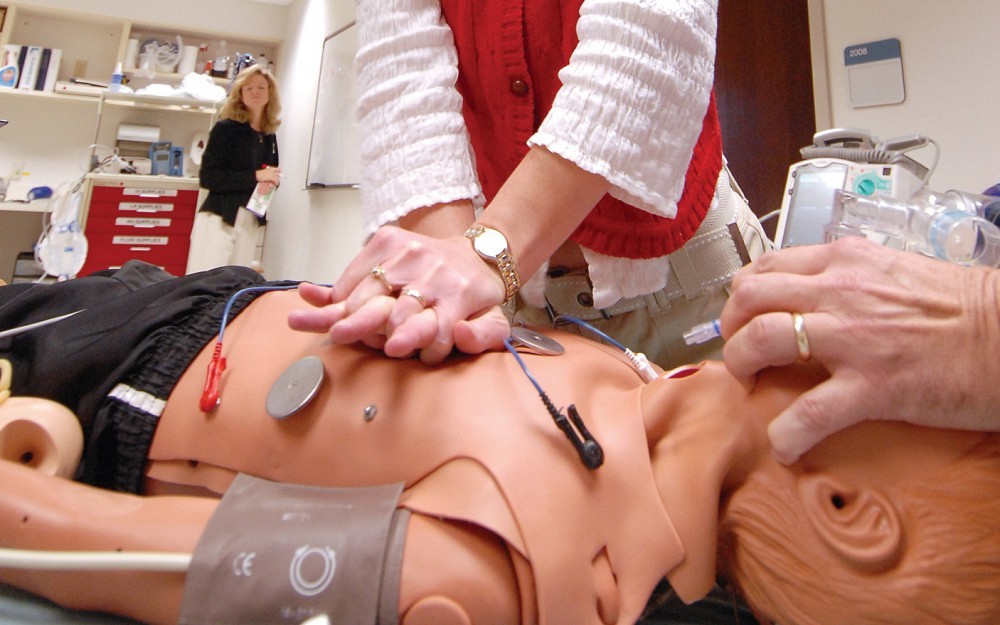
UC HEALTH LINE: Cincinnati Falls Behind in CPR Use, Training
CINCINNATIHeart disease is the No. 1 killer in the United States, with approximately 330,000 deaths each year.
It's estimated that more than 95 percent of cardiac arrest victims die before reaching the hospital.
CPR could prevent this, but in some citiesCincinnati includedthis lifesaving procedure is done at a lower frequency rate than elsewhere.
Cardiac arrest, which is different from a heart attack, is the abrupt halting of blood circulation in the heart.
Doctors in the cardiovascular diseases division and the emergency medicine department at UC say many lives could be saved if family members, friends or bystanders knewand usedCPR in emergency situations.
CPR, or cardiopulmonary resuscitation, is an emergency medical procedure used for victims experiencing cardiac arrest. It combines the use of artificial blood circulation with chest compressions and lung ventilation.
In March 2008, the American Heart Association and the European Resuscitation Council endorsed the effectiveness of chest compressions alonewithout artificial respirationfor adult victims who collapse suddenly in cardiac arrest.
Early CPR or defibrillation are the only two intervention tactics that have demonstrated an increased survival rate for cardiac arrest cases occurring outside of the hospital, says Imran Arif, MD, assistant professor in the cardiovascular diseases division.
Donald Locasto, MD, assistant professor in the emergency medicine department at UC and medical director for the Cincinnati Fire Department, says that both the number of people trained to administer CPR and those who administer the procedure to someone in need are somewhat low nationally.
But the numbers in Cincinnati are even worse.
For the calendar year 2008, the rate of bystander CPR nationally was 25.3 percent, he says. In Cincinnati, it was 11.5 percent. These low rates demonstrate a lack of CPR training and/or willingness of the pubic to step in.
It is a shame because more lives would be saved if a greater portion of our public were trained in and provided CPR.
He adds that that there should be more automated external defibrillators, or AEDs, available for public use in emergency situations.
AEDs are portable electronic devices that apply electrical therapy to patients who are in cardiac arrest, allowing the heart to re-establish an effective rhythm.
Arif agrees and adds that the sooner CPR or a defibrillator is used, the better chance a person has of survival.
If someone is experiencing cardiac arrest, alert emergency medical services and begin CPR immediately, he says. CPR can keep oxygenated blood flowing to the brain and other vital organs until a defibrillator becomes available or trained professionals arrive on the scene.
When the heart stops, the absence of oxygenated blood can cause irreparable brain damage in only a few minutes. Death will occur within eight to 10 minutes. Time is critical.
Warning signs of cardiac arrest include:
- Chest discomfort
- Discomfort or pain in one or both arms, the back, neck, jaw or stomach
- Shortness of breath
- Cold sweat
- Nausea
- Lightheadedness
In a small study by the University of Illinois College of Medicine in Peoria, researchers found that the Saturday Night Fever tune Stayin Alive has 103 beats per minutea perfect number to maintain blood flow in the heart and the best rhythm for performing CPR.
The study found that 10 doctors and five medical students who listened to the tune while practicing CPR not only performed perfectly, but also remembered the technique five weeks later.
But regardless of whether a disco hit can help people remember and perform CPR or not, Arif says training yourself is the first stepand a matter of life or death for those who need it.
Learn CPR for not only your loved ones, but also for others loved ones, he says. You could be their everyday hero.

Imran Arif, MD, interventional cardiologist for the division of cardiovascular diseases
Related Stories
Increasing syphilis cases highlight treatment barriers across...
May 14, 2024
The University of Cincinnati's Carl Fichtenbaum spoke with the Cincinnati Enquirer about a recent report that found Hamilton County syphilis cases reached a six-year high in 2023.
Cheers to saving lives
May 14, 2024
Hoxworth Blood Center is partnering with local breweries to host more than 15 mobile blood drives this summer.
Local 12: Brothers donate organs to their mother
May 13, 2024
Local 12 highlighted the story of Lynnette Knott, who received organ donations from sons Mark and Matt performed by University of Cincinnati physicians.
